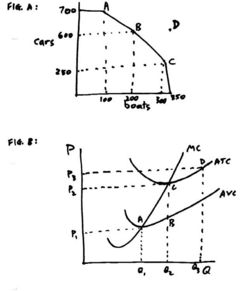Economics Model Answers Thirteen
Introductory:
1. The curve that illustrates how much a company or country can produce of multiple items is called the ________________________.
2. A monopolistic competitive firm has the following characteristic that is lacking for a perfectly competitive firm:
(a) There are low barriers to entry
(b) MR = MC in the long run.
(c) P > MC
(d) There are many competitors.
Answer is (c). For a perfectly competitive firm, P=MC.
Intermediate
3. A customer to our imaginary homeschool dinner expected to pay $40, but we only charged him $25. An economist would call the $15 difference the ___________. (Hint: see Lecture #10 review list)
4. Look at Figure B (right). If the price of sale falls below P1 then the firm in the short run will:
(a) increase Q
(b) increase labor
(c) increase price
(d) shut down.
How much profit is it making at a price of P2?
The firm should shut down because when P<P1, then P<ATC and P<AVC.
At the higher price P2, the firm would be making zero overall profit but would stay in business because P>AVC and is making marginal profits.
5. Look again at Figure B (right). Assume the firm is perfectly competitive. Explain what AFC is, and use the labels on the graph to describe its amount.
AFC is average fixed cost, which is the difference between ATC and AVC: AFC=ATC-AVC. Using the labels on the graph, AFC = C-B.
6. Now turn to Figure A (right). What is the opportunity cost of shifting production from B to C?
The opportunity cost is 600 minus 200 cars, which equals 400 cars.
7. Suppose that is your firm in Figure A (attached). What changes might enable you to move production to point D?
A marvelous new invention for my factories to increase their production.
8. The term “normal profit” means “zero economic profits,” which occurs when total revenue equals explicit costs (like cash expenditures) plus implicit costs (like opportunity costs of wasted time). In Figure B (attached), at point A, what kind of profits does the company have: (a) more than a “normal profit”, (b) equal to a “normal profit” or (c) less than a “normal profit.”? Explain.
Less than a normal profit because at point A the price is below ATC.
9. Do you support “free trade” or “protectionism”? Explain your view.
Protectionism because although free trade may appear to have immediate short run benefits for consumers in lower costs for goods, it also imposes long run costs in weakening our industries and strengthening our nation's enemies.
Honors:
10. Look at Figure C (right). Assuming it represents the long run, describe what type of industry this is (e.g., monopoly, oligopoly, monopolistic competition, or perfect competition). Explain your answer.
That looks like a monopoly because there is no supply curve, and the marginal revenue curve has twice the slope of the demand curve (i.e., the marginal revenue curve intersects the x-axis at one-half the quantity of the demand curve).
11. Economics is sometimes called the “dismal science” because economists predicted population to grow faster than the food supply, marginal returns to diminish, and profits to vanish. But, in fact, there is an abundance of food and profits have not vanished. Why is economics not so dismal after all?
Perhaps because mankind has increasing economies of scale: as population increases, output increases by a greater percentage due to inventions and improvements in production.
12. Look again at Figure C (attached). This question has three parts. (I) At what point is there an allocatively efficient quantity? (II) At what point is revenue maximized? (III) At what point is profit maximized? Explain your answers.

